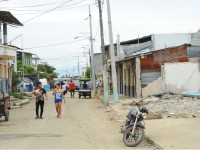Earthquake Reconstruction In San Jose de Chamanga, Ecuador

A 7.8 magnitude earthquake devastated Ecuador’s poor coastal communities, killing over 900 people in 2016. Jim Kostaras, Senior Fellow, working with the national government agency Empresa Publica de Vivienda, developed strategies to rebuild San José de Chamanga, an impoverished fishing community destroyed by the earthquake and subsequent tidal flooding. The recovery planning for San José de Chamanga was an opportunity for I2UD to offer an integrated model of community-based reconstruction and long-term development. In 2016, Ecuador was in an economic crisis; the national government lacked the resources for the reconstruction of Chamanga and similar communities. The earthquake has also exacerbated social and economic problems and dysfunction that have plagued this community. In an environment of persistent poverty, rampant drug abuse has undermined the social fabric of this community. Chamanga continues to require urgent attention including: the provision of shelter (close to 80% of dwellings were destroyed), potable water and sanitation, communal services and sources of income.
Poor land management has affected the ecological systems in the area around Chamanga resulting in vulnerabilities that exposed the community to severe impacts from the earthquake and subsequent flooding. Chamanga is situated within a complex network of mangrove ecosystems that historically have provided a buffer to extreme tidal flooding. The systematic destruction of the mangroves to make way for new construction and commercial shrimp farms made Chamanga particularly vulnerable to the recent earthquake.
The Chamanga community identified the following critical needs as priorities:
- A potable water delivery system and sanitation including water treatment.
- Housing.
- Construction of a women’s center, a safe house and clinic for women.
- Reconstruction of parks and public gathering space.
- Building the capacity of the local government council (the Junta Parroquial) to secure funding for reconstruction. Jim Kostaras also advised University of Pennsylvania graduate students, Aubrey Jahelka and Shuwen Ye, as they developed an innovative design proposal for Chamanga in a studio (and later as an independent project) taught by David Gouverneur, Associate Professor of Practice at the Department of Landscape Architecture at PennDesign; and Maria Altagracia Villalobos and Oscar Grauer, both Lecturers at the Department of Landscape Architecture at PennDesign. Their proposal addressed the ecological degradation of the region was caused by large scale aquatic farming (fostered by National policies), which was responsible for the eradication of over 85% of the mangrove ecosystems in the coastal region during the past two decades. These activities brought new investments to the region, however they are not labor intensive, and profits are not invested on the area. The destruction of the mangroves additionally caused sedimentation of the marshes, increased the risk of floods and effects of climate change/sea level rise, and also resulted in malnutrition of the communities and other health issues.
 Working with Jim Kostaras, Aubrey Jahelka and Shuwen Ye proposed a holistic recovery and resiliency strategy that restored the mangrove ecosystem, introduced more sustainable local economic development and offered a plan for the incremental construction of new housing. Similar to “triage” recovery responses to disasters in other countries, the National Government of Ecuador concentrated on the quick construction of new housing and provision of basic, often relocating people to new sites far from their original communities and livelihoods. The proposed UPenn strategy demonstrated a long-term development approach that considered the environmental factors that would reduce the Chamanga’s vulnerability to flooding and storm surges and increase the resiliency of this community.
For more information or the final paper, please email James Kostaras at Kostaras@i2ud.org
Working with Jim Kostaras, Aubrey Jahelka and Shuwen Ye proposed a holistic recovery and resiliency strategy that restored the mangrove ecosystem, introduced more sustainable local economic development and offered a plan for the incremental construction of new housing. Similar to “triage” recovery responses to disasters in other countries, the National Government of Ecuador concentrated on the quick construction of new housing and provision of basic, often relocating people to new sites far from their original communities and livelihoods. The proposed UPenn strategy demonstrated a long-term development approach that considered the environmental factors that would reduce the Chamanga’s vulnerability to flooding and storm surges and increase the resiliency of this community.
For more information or the final paper, please email James Kostaras at Kostaras@i2ud.org